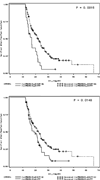Polymorphisms in the interleukin-4 receptor gene are associated with better survival in patients with glioblastoma
- PMID: 18927306
- PMCID: PMC2995250
- DOI: 10.1158/1078-0432.CCR-07-4681
Polymorphisms in the interleukin-4 receptor gene are associated with better survival in patients with glioblastoma
Abstract
Purpose: Previous literature provides some evidence that atopic diseases, IgE levels, and inflammatory gene polymorphisms may be associated with risk of glioblastoma. The purpose of this study was to investigate the effects of certain inflammatory gene single nucleotide polymorphisms (SNP) on patient survival. Malignant gliomas are the most common type of primary brain tumor in adults, however, few prognostic factors have been identified.
Experimental design: Using 694 incident adult glioma cases identified between 2001 and 2006 in Harris County, TX, we examined seven SNPs in the interleukin (IL)-4, IL-13, and IL-4 receptor (IL4R) genes. Cox proportional hazards regression was used to examine the association between the SNPs and overall and long-term survival, controlling for age at diagnosis, time between diagnosis and registration, extent of surgical resection, radiation therapy, and chemotherapy.
Results: We found that among high-grade glioma cases, IL4R rs1805016 (TT versus GT/GG) was significantly protective against mortality over time [hazard ratios (HR), 0.59; 95% confidence intervals (CI), 0.40-0.88]. The IL4R rs1805016 and rs1805015 TT genotypes were both found to be significantly associated with survival beyond 1 year among patients with high-grade glioma (HR, 0.44; 95% CI, 0.27-0.73 and HR, 0.63; 95% CI, 0.44-0.91, respectively). Furthermore, the IL4R haplotype analysis showed that SNPs in the IL4R gene may be interacting to affect long-term survival among high-grade glioma cases.
Conclusions: These findings indicate that polymorphisms in inflammation pathway genes may play an important role in glioma survival. Further research on the effects of these polymorphisms on glioma prognosis is warranted.
Figures


Similar articles
-
Polymorphism in the IL4R gene and clinical features are associated with glioma prognosis: Analyses of case-cohort studies.Medicine (Baltimore). 2016 Aug;95(31):e4231. doi: 10.1097/MD.0000000000004231. Medicine (Baltimore). 2016. PMID: 27495027 Free PMC article.
-
Allergy-related polymorphisms influence glioma status and serum IgE levels.Cancer Epidemiol Biomarkers Prev. 2007 Jun;16(6):1229-35. doi: 10.1158/1055-9965.EPI-07-0041. Cancer Epidemiol Biomarkers Prev. 2007. PMID: 17548690
-
Association and interaction of the IL4R, IL4, and IL13 loci with type 1 diabetes among Filipinos.Am J Hum Genet. 2003 Jun;72(6):1505-14. doi: 10.1086/375655. Epub 2003 May 13. Am J Hum Genet. 2003. PMID: 12748907 Free PMC article.
-
Favorable impact of the interleukin-4 receptor allelic variant I75 on the survival of diffuse large B-cell lymphoma patients demonstrated in a large prospective clinical trial.Ann Oncol. 2009 Sep;20(9):1548-1554. doi: 10.1093/annonc/mdp110. Epub 2009 Jun 10. Ann Oncol. 2009. PMID: 19515749 Clinical Trial.
-
Anti-angiogenic therapy for high-grade glioma.Cochrane Database Syst Rev. 2018 Nov 22;11(11):CD008218. doi: 10.1002/14651858.CD008218.pub4. Cochrane Database Syst Rev. 2018. PMID: 30480778 Free PMC article.
Cited by
-
A Metabolic Plasticity-Based Signature for Molecular Classification and Prognosis of Lower-Grade Glioma.Brain Sci. 2022 Aug 26;12(9):1138. doi: 10.3390/brainsci12091138. Brain Sci. 2022. PMID: 36138874 Free PMC article.
-
Allergic conditions reduce the risk of glioma: a meta-analysis based on 128,936 subjects.Tumour Biol. 2014 Apr;35(4):3875-80. doi: 10.1007/s13277-013-1514-4. Epub 2013 Dec 18. Tumour Biol. 2014. PMID: 24347487
-
Tumor-associated epilepsy and glioma: are there common genetic pathways?Acta Oncol. 2009;48(7):955-63. doi: 10.1080/02841860903104145. Acta Oncol. 2009. PMID: 19639468 Free PMC article. Review.
-
Integration of epidemiology, immunobiology, and translational research for brain tumors.Ann N Y Acad Sci. 2013 May;1284(1):17-23. doi: 10.1111/nyas.12115. Ann N Y Acad Sci. 2013. PMID: 23651189 Free PMC article.
-
Exposure of Microglia to Interleukin-4 Represses NF-κB-Dependent Transcription of Toll-Like Receptor-Induced Cytokines.Front Immunol. 2021 Nov 22;12:771453. doi: 10.3389/fimmu.2021.771453. eCollection 2021. Front Immunol. 2021. PMID: 34880868 Free PMC article.
References
-
- American Cancer Society. Cancer Facts and Figures. American Cancer Society; 2007.
-
- Wrensch M, Wiencke JK, Wiemels J, Miike R, Patoka J, Moghadassi M, McMillan A, Kelsey KT, Aldape K, Lamborn KR, Parsa AT, Sison JD, Prados MD. Serum IgE, tumor epidermal growth factor receptor expression, and inherited polymorphisms associated with glioma survival. Cancer Res. 2006:4531–4541. - PubMed
-
- Wrensch M, McMillan A, Wiencke J, Wiemels J, Kelsey K, Patoka J, Jones H, Carlton V, Miike R, Sison J, Moghadassi M, Prados M. Nonsynonymous coding single-nucleotide polymorphisms spanning the genome in relation to glioblastoma survival and age at diagnosis. Clin. Cancer Res. 2007:197–205. - PubMed
-
- Wang H, Diepgen TL. Is atopy a protective or a risk factor for cancer? A review of epidemiological studies. Allergy. 2005:1098–1111. - PubMed
-
- Schwartzbaum JA, Fisher JL, Aldape KD, Wrensch M. Epidemiology and molecular pathology of glioma. Nat. Clin. Pract. Neurol. 2006:494–503. - PubMed
Publication types
MeSH terms
Substances
Grants and funding
LinkOut - more resources
Full Text Sources
Other Literature Sources
Medical
Miscellaneous

